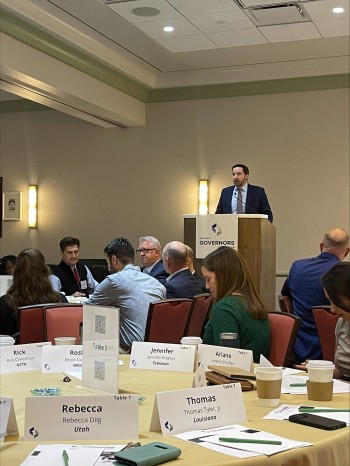The world of broadband policy has truly flipped over the past few years thanks largely to the passage of the Infrastructure Investment and Jobs Act, which will distribute historic amounts of funding to broadband infrastructure through the still-to-be-implemented BEAD program.
That is why our work at NTCA has extended beyond our federal viewpoint. We know it’s critical to truly partner with our state association executives and the many state broadband officials who are going to be on the frontlines for the distribution of a minimum of $100 million per state and as much multiple billions of dollars. This of course means there’s a great deal of work to be done in the next several months, starting with the release of the next version of maps and state allocations at the end of June.
Given the new “sandbox” for pondering, we have really built up our relationships with folks in key organizations like the National Governor’s Association (NGA). In fact, I am writing this blog post from a steaming hot and overly air-conditioned Las Vegas, home this week to the NGA Broadband Leaders Workshop. The event brings federal partners at the NGA, the National Telecommunications Information Administration, the U.S. Departments of the Treasury, Commerce, and Agriculture, the FCC and the Bureau of Land Management together with state and territory broadband leaders and some of us from industry/ public interest groups for a two-day discussion about why we are committed to #InternetForAll and what’s next.
Jennifer Prather, CEO of Totelcom (De Leon, Texas), joined me in sitting around the table and shared her perspective as one of the only rural providers in the room (for which I am deeply appreciative). For policymakers to hear what it really takes to build and maintain networks in rural America in this small setting was huge, and I am grateful that Jennifer rearranged her week to do this event.
The first day kicked off with thoughts from Kevin Gallagher, a top advisor to U.S. Secretary of Commerce Gina Raimondo, a key administration voice on broadband. We also had discussions on BEAD, leveraging other federal funding, prioritization, scoring, high-cost thresholds, digital equity, community outreach and adoption. The following day covered federal permitting improvements, delivery challenges, the expansion of the broadband workforce and the actual deployment of networks.
Of course, other top of mind issues were thrown into the mix as well, including supply chain issues, the Build America Buy America Act and satellite and fixed wireless. I was able to share some thoughts on how providing service in high-cost areas actually differs from the extreme high-cost threshold and how important it will be to hold this threshold high so we do not waste this once in a generation opportunity to push fiber as far into networks as possible. I had a few wireless folks jump in quickly after I shared the observation that we needed to do this right the first time and not look back in five years realizing that we squandered a moment. Thankfully, I saw many of the policymakers and state broadband leaders also nodding their heads in support of fiber prioritization.
While I can do without the Vegas heat and certainly without their stance of not having coffee makers in their hotel rooms (despite Starbucks not opening until 6 a.m.), the meeting reminded me of one of my favorite Hamilton songs, “The Room Where it Happens,” referring to a historical closed-door dinner held with Thomas Jefferson, Alexander Hamilton and James Madison that allowed them to reach an unprecedented political compromise on the future of the United States' financial system.
In the world of broadband policy, it’s critical to be in the room and this certainly was the right room to be in.



